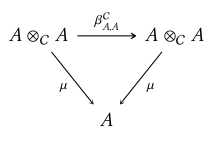Consider the following notion of a ring object, which works also for (some) non-Cartesian monoidal categories:
Let $(\mathcal{C},\otimes,\mathbf{1})$ be a monoidal category having Sweedler $\mathrm{Hom}$s and Sweedler products (for instance, we can take $\mathcal{C}$ to be a locally presentable braided monoidal category; see arXiv:1509.07632, Theorem 4.1).
Taking categories of bicommutative Hopf monoids gives us a category $\mathsf{HopfMon}^{\mathrm{bicomm}}(\mathcal{C})$, which by assumption admits a Sweedler product $\boxtimes$ making it into a monoidal category.
Then, define a (commutative) ring object in $\mathcal{C}$ to be a (commutative) monoid in $(\mathsf{HopfMon}^{\mathrm{bicomm}}(\mathcal{C}),\boxtimes,1)$.
Examples:
- This notion recovers (commutative) rings when applied to $\mathcal{C}=\mathsf{Sets}$, as $\mathsf{BiHopf}^{\mathsf{bicomm}}(\mathsf{Sets})\cong\mathsf{Ab}$ and the Sweedler product in $\mathsf{Ab}$ is the tensor product of abelian groups.
- More generally, rings in Cartesian monoidal categories coincide with the usual notion of a ring object in a category with finite limits.
- Rings in $(\mathsf{Ab},\otimes_{\mathbb{Z}},\mathbb{Z})$ and $(\mathsf{Rings},\otimes_{\mathbb{Z}},\mathbb{Z})$ are plethories.
Question. What are some other examples of rings in monoidal categories? Has this non-Cartesian variant been studied before?
Edit: Here's some background on Hopf monoids in monoidal categories, as requested in the comments by Paul Taylor.
Let $(\mathcal{C},\otimes,\mathbf{1})$ be a monoidal category. A monoid in $\mathcal{C}$ consists of an object $A$ of $\mathcal{C}$ together with maps $\mu\colon A\otimes A\to A$ and $\eta\colon\mathbf{1}\to A$ making the diagrams
commute. For example, monoids in the Cartesian monoidal category of sets recover ordinary monoids, while monoids in $(\mathsf{Ab},\otimes_{\mathbb{Z}},\mathbb{Z})$ recover (non-commutative) rings. Moreover, if $\mathcal{C}$ has a braided monoidal structure, we say that a monoid $(A,\mu,\eta)$ in $\mathcal{C}$ is commutative if the diagram
commutes. Again, this recovers commutative monoids and commutative rings when applied to $\mathsf{Sets}$ and $\mathsf{Ab}$.
Dually, a comonoid in $\mathcal{C}$ is a monoid in $\mathcal{C}^{\mathsf{op}}$: it is a triple $(C,\Delta,\epsilon)$ consisting of an object $C$ of $\mathcal{C}$ equipped with maps $\Delta\colon C\to C\otimes C$ and $\epsilon\colon C\to\mathbf{1}$ making the diagrams
commute. Cocommutative comonoids are defined dually to commutative monoids.
Any object of a Cartesian monoidal category is canonically a comonoid when equipped with the diagonal and projection to the unit maps. They are quite more interesting if the category in question is non-Cartesian, however: in $\mathsf{Mod}_{R}$, for instance, they give rise to $R$-coalgebras.
Now, we can also consider bimonoids in (a braided monoidal category) $\mathcal{C}$. These are objects of $\mathcal{C}$ equipped with both a monoid and a comonoid structure in a compatible way (image from the bialgebra page in Wikipedia):
A bimonoid in $\mathcal{C}$ is bicommutative if it is commutative and cocommutative.
A Hopf monoid in $\mathcal{C}$ is a bimonoid $H$ in $\mathcal{C}$ together with a morphism $\sigma\colon H\to H$, called the antipode of $H$, making the diagrams
commute. In a sense, Hopf monoids are bimonoids with inverses: bimonoids in $\mathsf{Sets}$ are monoids, but Hopf monoids in $\mathsf{Sets}$ are groups.
The classical examples of bimonoids and Hopf monoids are bialgebras and Hopf algebras.
Lastly, here are some comments on Sweedler theory. Given a comonoid $C$ and a monoid $A$ in a closed monoidal category $\mathcal{C}$, one can form a new monoid $[C,A]$, called the convolution monoid of $C$ and $A$. When $\mathcal{C}=\mathsf{Sets}$, this means we can endow a set of the form $\mathrm{Hom}_{\mathsf{Sets}}(X,M)$ with $X$ a set and $M$ a monoid with a monoid structure consisting of
- The multiplication map sending a pair $f,g\colon X\rightrightarrows M$ of maps of sets to the map $f*g$ defined by $$ (f\ast g)(x)\overset{\mathrm{def}}{=}f(x)g(x) $$
- The unit map $\Delta_{1_M}$ defined by $$ \Delta_{1_{M}}(x) \overset{\mathrm{def}}{=} 1_{M}. $$
Taking convolution monoids in $\mathcal{C}$ defines a functor $$ [-_{1},-_{2}] \colon \mathsf{CoMon}(\mathcal{C})^{\mathsf{op}} \times \mathsf{Mon}(\mathcal{C}) \longrightarrow \mathsf{Mon}(\mathcal{C}). $$ When $\mathcal{C}$ is sufficiently nice, this functor becomes part of a two-variable adjunction involving two new functors $$ \begin{align*} -_{1}\triangleright-_{2} &\colon \mathsf{CoMon}(\mathcal{C})\times\mathsf{Mon}(\mathcal{C}) \longrightarrow \mathsf{Mon}(\mathcal{C}),\\ \{-_{1},-_{2}\} &\colon \mathsf{Mon}(\mathcal{C})^{\mathsf{op}}\times\mathsf{Mon}(\mathcal{C}) \longrightarrow \mathsf{CoMon}(\mathcal{C}), \end{align*} $$ called the Sweedler product and the Sweedler $\mathrm{Hom}$ (or the measuring comonoid), respectively.
These are harder to describe, but for example the Sweedler $\mathrm{Hom}$ in $\mathsf{Sets}$ is given by the functor $$ \mathrm{Hom}_{\mathsf{Mon}} \colon \mathsf{Mon}^{\mathsf{op}}\times\mathsf{Mon} \to \mathsf{Sets} $$ taking a pair of monoids $A$ and $B$ to the set $\mathrm{Hom}_{\mathsf{Mon}}(A,B)$ of monoid maps from $A$ to $B$.
When $\mathcal{C}=\mathsf{Mod}_{R}$, Sweedler $\mathrm{Hom}$s are given by measuring $R$-coalgebras. These make sense also in the ($\infty$-)category of spectra; see arXiv:2006.09408 and Péroux's PhD thesis.
A fundamental example of the Sweedler product is given when $\mathcal{C}$ is the category of bicommutative Hopf monoids in $\mathsf{Sets}$, i.e. the category of abelian groups, where we recover the tensor product of abelian groups.
Sweedler theory has also been carefully worked out by Anel and Joyal in arXiv:1309.6952 in the setting of dg-co/algebras.
TL;DR. A comonoid in a monoidal category $\mathcal{C}$ is the dual notion of a monoid in $\mathcal{C}$. A bimonoid in $\mathcal{C}$ is a monoid and a comonoid in $\mathcal{C}$ in a compatible way. A Hopf monoid in $\mathcal{C}$ is roughly a bimonoid in $\mathcal{C}$ with inverses. We can convolve a comonoid $C$ with a monoid $A$, giving a kind of Hom set of maps from $C$ to $A$. This convolution monoid admits adjoints in nice situations, allowing us to tensor monoids with comonoids and to enrich $\mathsf{Mon}(\mathcal{C})$ in $\mathsf{CoMon}(\mathcal{C})$.





